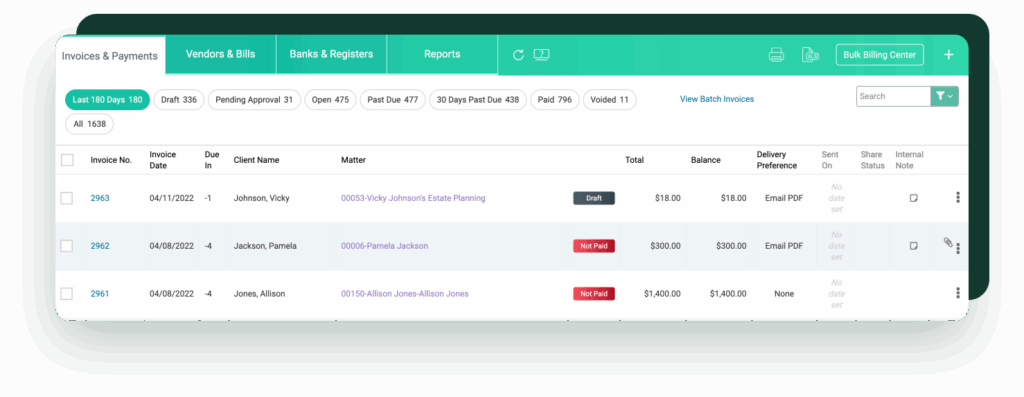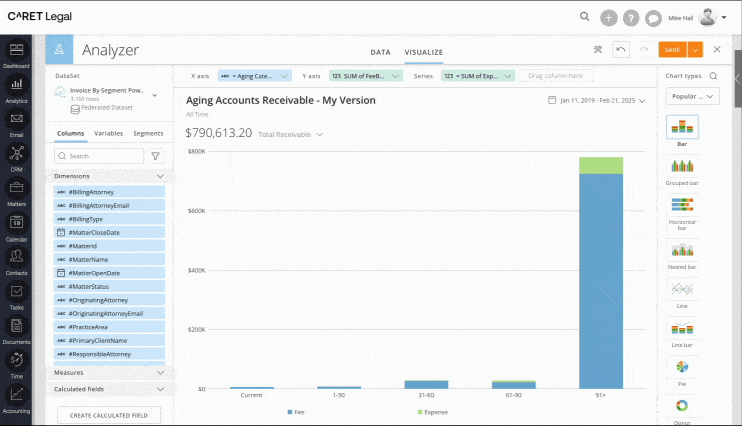The big takeaways:
- Alternative Fee Arrangements (AFAs) give clients predictable costs while allowing firms to align legal payment models with value and efficiency.
- CARET Legal supports AFAs through flexible billing templates, workflow tools, and automated legal documents that simplify administration.
- Tracking profitability alongside AFAs helps firms strengthen margins and meet client expectations without losing visibility into billable hours.
Flat fees, contingency fees, and hybrid models have shifted from niche offerings to a more common practice in the legal market. Corporate clients increasingly ask firms to replace or supplement hourly billing with a legal payment model that provides predictable costs. Smaller clients, too, prefer arrangements that avoid large retainers and uncertain invoices.
Hourly billing has limitations. Clients cannot budget if they do not know how many hours their matter will take, and firms risk client dissatisfaction if the final bill exceeds expectations. Alternative Fee Arrangements (AFAs) respond to these concerns by focusing on outcomes and value. Flat fees cover entire matters or phases of work. Contingency fees tie compensation to results. Hybrid models balance hourly tracking with fixed pricing for defined tasks.
AFAs are not just client-friendly; they can also improve access to justice. A flat fee for a routine service, such as estate planning documents, lowers the entry barrier for individuals who may otherwise avoid hiring counsel due to cost concerns. By aligning fees with client expectations, firms strengthen relationships and open new markets.

How Legal Practice Management Tools Utilize AFAs
Implementing AFAs requires systems that can handle non-hourly billing without losing track of the work being done. A firm that offers flat-fee services still needs insight into profitability. Without the right tools, AFAs can create administrative challenges, from tracking payments to managing task progress.
This is where legal workflow software, like CARET Legal, makes a measurable difference. CARET Legal allows firms to set up flexible billing templates that match a variety of AFAs. For example, a flat fee can be assigned to a matter while time is still tracked internally.
CARET Legal also integrates billing with legal task management. Attorneys and staff can connect time entries, documents, and tasks to the same matter record. This ensures that even if the client sees only a flat fee, the firm retains a clear picture of how resources are allocated. The result is greater transparency with clients and better insight for firm leaders.
Driving Profitability with Legal Automation and Workflows
Flat fees and other AFAs can reward efficiency. When the amount billed is fixed, the less time wasted on redundant tasks, the better the margin. CARET Legal supports this model by combining legal automation software with workflow tools that keep cases moving smoothly.
- Automated Workflows: CARET Legal can schedule tasks and deadlines at each stage of a matter. This ensures consistency across cases, helping teams manage work within a set structure.
- Automated Legal Documents: Document software can reduce drafting time, especially for high-volume practices. By standardizing forms and automating repetitive drafting, firms save hours that would otherwise cut into profitability under a flat fee.
- Integrated Communication: Because documents, emails, and tasks are linked in one system, attorneys spend less time searching across platforms. The efficiency gained translates directly into healthier returns on fixed-price matters.
By reducing administrative overhead and avoiding missed steps, CARET Legal gives firms the operational discipline needed to thrive under AFAs. Attorneys spend more time on substantive client work and less on repetitive or manual processes.
Tracking Performance and Building Client Confidence
While AFAs move client billing away from strict hourly charges, firms still benefit from tracking time internally. CARET Legal permits time entries on flat-fee or contingency matters (often treated as non-chargeable), enabling leadership to evaluate matter profitability, refine processes, and compare performance against hourly-model matters.
Reporting dashboards provide firm leaders with visibility into:
- Profitability by practice area
- Effective rate by attorney
- Collection by customer rates
- Most profitable clients
This transparency is just as valuable for clients. With CARET Legal, firms can provide clear invoices and explain exactly what is included under a flat fee or contingency model. Clients see the alignment between costs and outcomes, while firms gain trust and repeat business.

Making AFAs Work for Your Firm
Clients expect predictable pricing and transparency, while firms seek ways to maintain profitability and efficiency. AFAs help bridge those goals by aligning fees with outcomes and value rather than only billable hours.
CARET Legal supports this balance through flexible billing options, workflow automation, and reporting tools that give firms insight into both client satisfaction and internal performance. Flat fees, contingency arrangements, and task-based pricing can all be set up within the platform, with time still tracked internally to monitor profitability. Automated legal documents and structured workflows further reduce inefficiencies, strengthening margins under fixed-fee models.
Start your free trial of CARET Legal today and see how flexible billing and workflow tools can help your firm manage AFAs with clarity and confidence.
